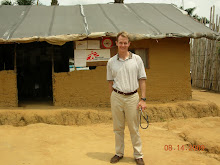There are three choices of non-gorilla activities. The most popular is a short hike in the forest to spend time with golden monkeys. Like the gorillas, these small primates have been habituated to human contact. I asked several people about the experience and received reviews varying from "fantastic" to "they were up in the tree tops so don't waste your money." So no golden monkeys for me. Another possibility for a day trip is a hike to Diane Fossey's grave. She lived in these mountains, studying and educating the public about mountain gorillas. She was murdered in 1987 and is buried just outside the park boundaries. Not having read or seen "Gorillas in the Mist" I decided to forego this activity. The third possible choice is Bisoke.

Parc National de Volcans encompasses five extinct volcanoes. They form the border between Rwanda, Uganda, and the Democratic Republic of Congo. From the Rwandan side it is possible to climb two of these mountains. Karisimbi is a two day trip but Bisoke can be hiked in a day. To me, on a visit to Volcanoes National Park, isn't it logical to try to climb one of the volcanoes?
The National Park charges seventy-five dollars per person (including a guide) to climb the mountain. As I predicted, there were no other tourists wanting to go today. I had the guide to myself! I am sometimes a fast hiker and groups of varying abilities can be exasperating.
We began the trip by walking through beautiful fields of flowers resembling daisies, grown and harvested to produce a natural insecticide. After a gradual ascent through the flowers, we crossed a stone fence that encloses the national park, built to keep people out and wild animals in. The going got rough almost immediately. The path was steep and very muddy. Following each step forward I slid back a half step. The guide and I proceeded through several different vegetation zones and saw a lot of fresh droppings (including gorilla) and footprints, but no living animals. The path got steeper and I repeatedly thought "how are we going to go down this?" I considered calling it all off several times (40% of tourists do so) but 4 ½ hours after starting, we arrived. At the summit of 3711 meters (about 11,500 feet) lies a perfect crater lake. On the other side of the water lay Congo—home!

After a short break for lunch we started down. For me, this was much worse than ascending, though faster due to my innumerable falls and slides. My hiking boots were dirtier than I have ever seen them, likely due to hundreds of dunkings in 6 inch deep mud.
The path down took slightly under four hours. When we crossed the stone fence to exit the park I was exhausted, happy, and relieved to have stopped sliding and losing my footing.
Was it worth it? Definitely. Would I recommend it? Only for people who are very fit and have excellent hiking boots, rain gear, and lots of determination. And only in the dry season, though the guide told me there is mud even then, as the summit is usually in clouds. If descending steep muddy trails makes your ears burn with anticipation, it is perfect. I loved the experience and am pleased I persisted to the summit but tonight am hungry, tired, and sore!

No comments:
Post a Comment